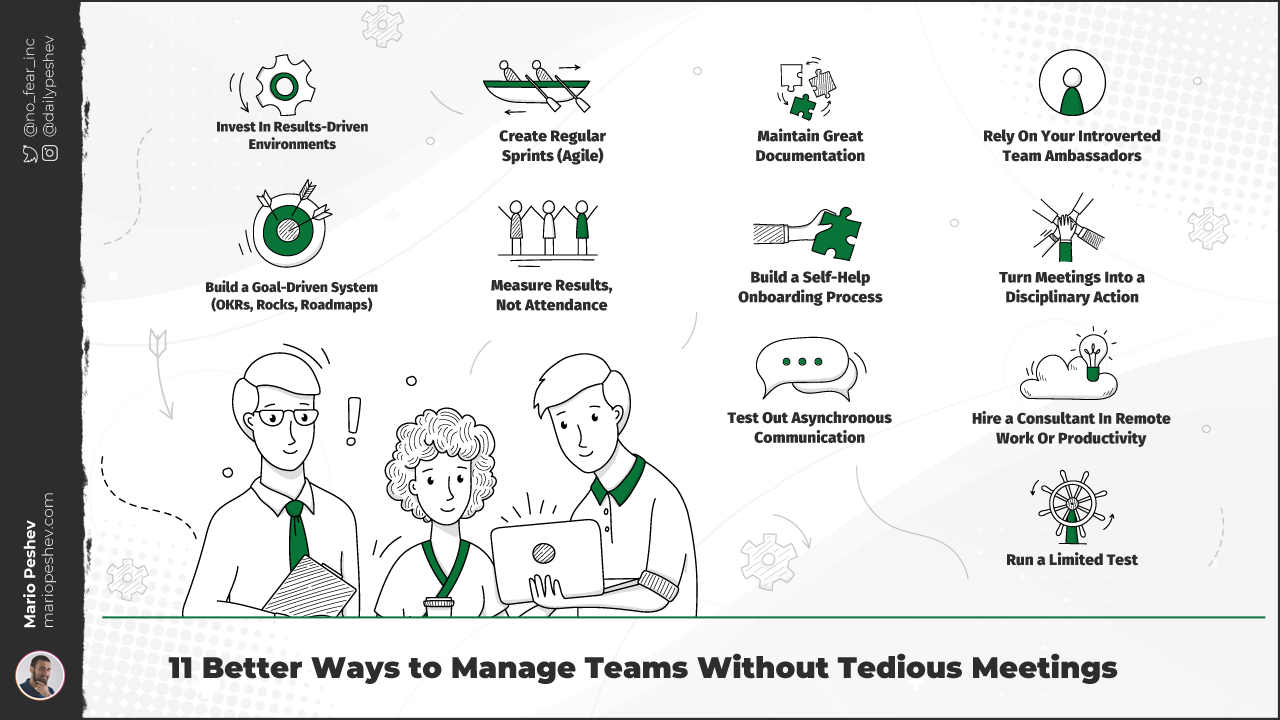As a firm evangelist of the values of asynchronous communications, I’m strongly opinionated when it comes to meetings.
Meetings are not all evil. I’ve covered some workarounds for meetings (when necessary) and several reasons to set up a meeting. But beyond that, meeting creep is so prevalent—especially in the context of remote/hybrid environments—that productivity and work satisfaction are almost non-existent right now.
According to a study led by Microsoft, virtual meeting hours increased by 252 percent. As a result, today’s experts (including me), are full of suggestions for improving meetings or simply how to avoid them.
In the coming 3 years virtual meetings will go up to 50% of the overall virtual events.
By 2025, the video meeting platform that their company regularly uses will host 50% of all virtual workplace events.
Source: quixy
I have two businesses that barely depend on frequent meetings (one of them has no meetings whatsoever). Even in an on-site environment, I would rather preach for group lunch breaks where work conversations are forbidden than having regular syncs for its sake.
If you’re in a position where meeting scheduling depends on you or want to influence a decision maker’s opinion, feel free to use this checklist (or share the entire post) to make your case. And if you want me to vouch for you—hit me up, and I’ll step in.

1. Invest In Results-Driven Environments
Most meeting advocates vouching for meetings don’t account for the total time invested in a given meeting.
- First, meeting effectiveness varies a lot. A lot of internal meetings are bound to start a little late until everyone gathers (or expect people to join earlier and stay put).
- The substance of a meeting is a fraction of the time spent together. Between casualties and wrapping up, the effective time brainstorming varies a lot.
- Lots of meetings include far too many people. This automatically decreases the overall meeting usefulness.
- Some meetings require follow-up notes or reviews or adjusting the daily/weekly agenda, which often means that other tasks have to be pushed back or different meetings rescheduled accordingly.
ROWE (Results-Only Work Environment) was the very first flexible paradigm I encountered back in 2006 or 2007. This reinforced the idea of KPIs and ROI for both the business and the individuals, and the shallowness in tying any metric to time on site.
Even if you leave with just one single takeaway today, let it be this one.
Focus your business—and the individual roles and responsibilities—on results and deliverables. Great performers will deliver with no supervision. Poor performers don’t need to waste your time chasing them—set the ground rules, define expectations, and fire if freedom is abused. It’s that simple.
2. Build a Goal-Driven System (OKRs, Rocks, Roadmaps)
Developing a whole new paradigm around goals may be daunting for many (especially if your business isn’t set for targets).
If ROWE sounds too flexible as a model – it is not the holy grail for everyone. Fixed hours and presence are still mandatory for plenty of roles outside of digital (and even administrative or support roles).
But guess what—the chef at the restaurant doesn’t spend 20+ hours in weekly meetings. Nor does the sales agent in your clothing store. Or the waiter at the bar down the street.
Because productivity is derived by work quota and targets.
Modern businesses can adapt KPI-driven methodologies and cascade work productivity further down the chart. Some examples in practice:
- Projects in practice are built around roadmaps – defining the high-end scope, vision, and time frames. Measuring success is predictable.
- OKRs were invented in Google back in 1999 as a high-level framework for defining quarterly objectives and key results. Beyond the senior management team, OKRs can be drilled down or even defined internally for every team.
- EOS is a more comprehensive, full-stack management framework including 6 key components that every business requires: Vision, People, Data, Issues, Process, Traction. With over 130,000 companies adopting EOS and thousands of implementers, this paradigm covers every step of the process.
(If you need an EOS implementor, I’ve worked with three of them and would love to make an intro).
Bottom line—if results and KPIs are hard to define, there are systems in place to get you there.
3. Create Regular Sprints (agile)
A common disconnect between teams and leadership is the lack of visibility and progress on a regular cadence, also known as “velocity”.
If team utilization is hard to define, investing in talent is also hard to justify. Moreover, do you need 5 support reps instead of 3? Or what’s the capacity available to take on a new client?
Agile development has defined the term “Sprint” as a regular iteration of work that’s organized upfront and ensures effective utilization of the team. Just as you define sales quotas or weekly amount of content to be delivered, most teams can organize their work with sprints – enabling visibility for other departments, accountability for themselves, and most importantly – a clear mechanism to indicate goals and progress upfront throughout the week.
Turn weekly status meetings into a thing of the past. Get the pulse of the sprint whenever you want in a neatly organized format within a project management system internally. You’ll be surprised to learn how tens of thousands of large companies operate by only focusing on results—some even going as far as banning meetings altogether.
Also, no meeting weeks increased productivity by 73% according to a broader study.
4. Measure Results, Not Attendance

One of the key flaws resulting in more meetings is the premise that attendance means results.
Lack of regular meetings tends to beg more questions as to “how do people spend their time”, and especially in a remote environment—all hypotheses arise.
Justin Mitchell is the founder and CEO of Yac. His company creates an asynchronous meetings platform, which caters to different work styles. Justin shares a story of one of his recent clients who strongly believes that the only way for a manager to know his team is working is by having them all day long on Zoom calls.
“And I’m like, ‘Okay, all right. If that’s the only way you know they’re working, you’re measuring things wrong. You’re measuring input, not output,’” Justin says.
Of course, it doesn’t help that the communities around working multiple jobs gained popularity during the pandemic with a concerning number of people working even 3 or 4 jobs at a time. Or, even engaging in intercourse during business hours.
Have people been abusing remote work? Absolutely—and it’s not the vocal minority at all.
But the question is: how do meetings solve that problem? Are they designed to publicly shame underperformers? Is that a form of having “multiple standups” daily?
Assign expectations and set due dates. Let work happen. Measure results.
Productive employees are effectively bashed with more and more meetings while professional slackers have invented thousands of ways to procrastinate and post useless reports online without lifting a finger. It’s the equivalent of office workers with their cluttered desks with folders piling up from all over the place because they are “so busy” playing solitaire.
There’s an entire cult around The Office for a reason.
5. Maintain Great Documentation
Another passable reason for having more meetings is institutional knowledge dispersed across just a handful of people.
Onboarding new colleagues or moving teammates from one project to another is not a productive exercise if documentation has not been maintained to date.
And realistically, the people who have the broadest understanding of a project are your high performers, senior managers, leads, or individual contributors who carry a lot of work. Wasting their time on meetings is hardly a valid excuse.
Since booking a week of their time to catch up on documentation isn’t the brightest idea, you may:
- Establish a recurring process for documentation updates. It could be once a week, bi-weekly, or monthly, allowing for drip updates taking 10-15 minutes a week.
- Hire project managers. Or project coordinators. Or executive assistants. Ops people. Anyone to support your top performers in recapping meetings or client calls, maintaining documentation over time, consolidating knowledge, and being the gatekeeper to your valuable talent.
- Ask your staff to record onboarding videos. An introductory video can take 30-60 minutes to record, including some screencasting or whiteboarding (whatever helps). Compare that to organizing a 20-page document with screenshots or charts and links, or having to be in 40+ hours of relevant meetings in a year.
6. Build a Self-Help Onboarding Process
Onboarding is one of the meeting-heavy exercises that are integral to bringing new talent up to speed.
While shadowing and standups are really supportive over the first weeks – building a self-help onboarding process where candidates can pick up “at their own pace” is a great investment in your process suite.
This can include:
- Documentation (as discussed in the previous point)
- A breakdown of the first few weeks (expectations, goals, process definition)
- Consolidated documentation of tooling and systems – including existing links to help desks of software apps in use such as Asana, Slack, Confluence, etc.
- An introductory email including misc and FAQ such as working hours, lunch breaks, check-in/out process, or any on-site details like nearby restaurants, cafes, you name it
- Guided videos on anything within your industry, or external training courses on soft skills, diversity, communication skills – anything you would normally need to calibrate on over the first few weeks
- A sample project with actionable tasks to bring them up to speed. Ideally for a sandbox process that mimics the real world, but definitely not a deep-dive from week one.
7. Test Out Asynchronous Communication
An experiment at Asana has proven how much meeting time is unnecessary from the perspective of the workers. When asked to “clear their calendars of meetings, and then rebuild it based on how much time these workers actually needed to spend in meetings, the amount of time allotted for meetings was drastically cut. The thirty-minute meetings are now 15 minutes, and as a result, more people were productive and motivated.
If you still don’t buy into the idea of killing most meetings, put that to the test.
- Organize a meeting-free week. See what happens. One of the studies linked above reported a massive bump in productivity, and that’s the expectation. Another study measured an increase of 71% in productivity because employees felt more empowered and in control.
- Pick a couple of meetings internally and kill them. Try that for a month. What’s missing? Is there anything lost that can’t be handled without a weekly meeting?
- Move your reporting to an asynchronous format. Instead of a daily standup, move that to an email thread, a tool like Status Hero, or a Slack bot. People can check in whenever. You already need to do this if you work internationally anyway.
- Scrutinize other meetings. Ask for clear agenda. Validate each of them – could that happen in a PM system instead? Is a meeting really necessary?
- Try any of the async communication tools I’m using on a daily basis.
Assuming that meetings are a necessity is impairing the open-mindedness that moves massive organizations forward, especially product companies working across the globe where the only way to maintain context is asynchronously.
8. Rely On Your Introverted Team Ambassadors
Meetings are taking a toll on your introverted colleagues.
If you haven’t conducted a Myers Briggs test yet, or the Big 5 OCEAN assessment (or any other psychometry test whatsoever), try it out. A good percentage of the largest companies out there use it for management, feedback reviews, and even hiring.
While extroverts get charged by meeting people and exchanging ideas, introverts get drained. Big time.
As an INFJ myself, I can absolutely relate to that. Over the years, I’ve had colleagues quitting because of peer pressure and too much noise, and a lack of ability to get the job done.
Most of my creative friends are freelancers or work in remote companies ONLY because of the meeting intensity on-site and being unable to recharge even after hours or late at night.
Extroverts can connect, meet, chat, hang out after hours, meet around the water cooler, and sit on the phone before and after work. Killing meetings is not discriminatory to extroverts but puts pressure on the introverts. So use your introverted talent as advocates and work with them toward an inclusive environment.
9. Turn Meetings Into a Disciplinary Action
Nobody on their deathbed said, “I wish I was in more meetings”.
Work can be fun, and rewarding. Not all of it, but for the most part.
Writers can write, designers can design, developers can develop, and so forth. Meetings put a hold on the process for every “doer” role.
So my solution to converting organizations to async teams is boiled down to one key action item:
Using meetings as a form of punishment, or as a part of an informal PIP process.
Your top performers can excel and thrive individually. A brief email or a couple of pings on Slack are sufficient to get the ball rolling.
So using meetings as a layer to request adherence to deadlines or quality of work is the response for underperformers.
Of course, in the best-case scenario, you would identify and deal with underperformers thanks to KPIs and clear requirements. But rewarding your effective team with independence is the right thing to do—and not burdening them because of the low-performers.
10. Hire a Consultant In Remote Work Or Productivity
When in doubt—hire consultants 😄
Seriously, though. Meetings are an operational problem, and there are business frameworks and systems to push the entire process in the right direction.
Killing ALL meetings is impossible, and honestly—harmful. But I could confidently say that approximately 70% of all meetings can easily be dropped and moved to a more inclusive process.
Back when I started my career as an independent contractor in 2008, I studied remote work and management principles from the likes of Automattic and Basecamp, their communication paradigms, and strategies. Many more have emerged since, including other titans like Gitlab preaching the productive ways.
I have supported dozens of companies to reduce meetings and optimize business dynamics. But pairing with virtually anyone experienced in working within a similar environment can be eye-opening.
You can’t fathom what an async productive workplace is until you invest in changing the entire workflow internally or work with people who made the switch. You can compare it with switching to vegetarianism or adopting meditation or any other practice. It’s easy to pick up but looks dangerous, and spending time with converts sounds so much more logical.
11. Run a Limited Test
Once again—try to test out the premise of async work internally. It could be a limited test:
- Run a 2-week async policy internally unless really necessary
- Drop meetings within a specific department. See how it works for them (and no, don’t pick Sales or Recruitment for the pilot)
- Pull people out of meetings. See what is missing. Analyze why.
- Teach your staff better communication, planning, and risk management principles.
- Adopt sprints. Weekly planning helps limit disruptions during the week.
Whatever you decide to test—thank you for supporting the greater good in not wasting precious time and trying to increase joy at the workplace.




